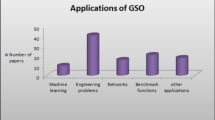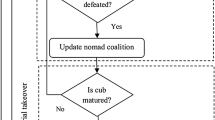Abstract
In this paper, we intend to propose a new heuristic optimization method, called animal migration optimization algorithm. This algorithm is inspired by the animal migration behavior, which is a ubiquitous phenomenon that can be found in all major animal groups, such as birds, mammals, fish, reptiles, amphibians, insects, and crustaceans. In our algorithm, there are mainly two processes. In the first process, the algorithm simulates how the groups of animals move from the current position to the new position. During this process, each individual should obey three main rules. In the latter process, the algorithm simulates how some animals leave the group and some join the group during the migration. In order to verify the performance of our approach, 23 benchmark functions are employed. The proposed method has been compared with other well-known heuristic search methods. Experimental results indicate that the proposed algorithm performs better than or at least comparable with state-of-the-art approaches from literature when considering the quality of the solution obtained.









Similar content being viewed by others
References
Melanie M (1999) An introduction to genetic algorithms. MIT Press, Massachusetts
Sivanandam SN, Deepa SN (2008) Introduction to genetic algorithms. Springer, Berlin
Kennedy J, Eberhart R (1995) Particle swarm optimization. Proc Int Conf Neural Netw 4:1942–1948
Engelbrecht AP (2005) Fundamentals of computational swarm intelligence. Wiley, New Jersey
Karaboga D, Basturk B (2007) A powerful and efficient algorithm for numerical function optimization: artificial bee colony (ABC) algorithm. J Global Optim 39(3):459–471
Karaboga D, Basturk B (2008) On the performance of artificial bee colony (ABC) algorithm. Appl Soft Comput 8(1):687–697
Simon D (2008) Biogeography-based optimization. IEEE Trans Evol Comput 12(6):702–713
Yang XS, Deb S (2009) Cuckoo search via Levy flights, in: world congress on nature & biologically inspired computing (NaBIC 2009). IEEE Publication, USA, pp 210–214
Yang XS, Deb S (2010) Engineering optimisation by cuckoo search. Int J Math Modell Numer Optim 1(4):330–343
Horn J, Nafpliotis N, Goldberg DE (1994) A niched Pareto genetic algorithm for multiobjective optimization. Evol Comput 1:82–87
Clerc M, Kennedy J (2002) The particle swarm-explosion, stability, and convergence in a multidimensional complex space. IEEE Trans Evol Comput 6:58–73
Mohan BC, Baskaran R (2011) Energy aware and energy efficient routing protocol for adhoc network using restructured artificial bee colony system. Commun Comput Inf Sci 169(3):473–484
Rao RV, Patel VK (2011) Optimization of mechanical draft counter flow wet-cooling tower using artificial bee colony algorithm. Energy Convers Manage 52(7):2611–2622
Karaboga D, Ozturk C, Karaboga N, Gorkemli B (2012) Artificial bee colony programming for symbolic regression. Inf Sci 209:1–15
Li X, Yin M (2011) Hybrid differential evolution with biogeography-based optimization for design of a reconfigurable antenna array with discrete phase shifters. Int J Antennas Propag 2011. Article ID 685629
Li X, Wang J, Zhou J, Yin M (2011) A perturb biogeography based optimization with mutation for global numerical optimization. Appl Math Comput 218(2):598–609
Li X, Yi M (2012) Multi-operator based biogeography based optimization with mutation for global numerical optimization. Comput Math Appl 64(9):2833–2844
Walton S, Hassan O, Morgan K, Brown MR (2011) Modified cuckoo search: a new gradient free optimisation algorithm. Chaos Solitons Fractals 44:710–718
Gandomi AH, Yang XS, Alavi AH (2011) Cuckoo search algorithm: a metaheuristic approach to solve structural optimization problems. Engineering with Computers, 27, July
Layeb A (2011) A novel quantum inspired cuckoo search for knapsack problems. Int J Bio Inspir Comput 3:297–305
Wolpert DH, Macready WG (1997) No free lunch theorems for optimization. IEEE Trans Evol Comput 1:67–82
Dyer JRG, Ioanno CC, Morrell LJ, Croft DP, Couzin ID, Waters DA, Krause J (2008) Consensus decision making in human crowds. Anim Behav 75(2): 461–470
Braha D (2012) Global civil unrest: contagion, self-organization, and prediction. PLoS ONE 7(10):e48596. doi:10.1371/journal.pone.0048596
Ballerini M, Cabibbo N, Candelier R, Cavagna A, Cisbani E, Giardina I, Lecomte V, Orlandi A, Parisi G, Procaccini A, Viale M, Zdravkovic V (2008) Interaction ruling animal collective behavior depends on topological rather than metric distance: evidence from a field study. Proc Natl Acad Sci USA 105(4):1232–1237. arXiv:0709.1916. Bibcode 2008PNAS.105.1232B. doi:10.1073/pnas.0711437105. PMC 2234121. PMID 18227508.//www.ncbi.nlm.nih.gov/pmc/articles/PMC2234121/
Storn R, Price K (1997) Differential evolution-a simple and efficient heuristic for global optimization over continuous space. J Global Optim 11:341–359
Li X, Yin M (2013) An opposition-based differential evolution algorithm for permutation flow shop scheduling based on diversity measure. Adv Eng Softw 55:10–31
Li X, Yin M (2012) Application of differential evolution algorithm on self-potential data. PLoS ONE 7(12):e51199
Rashedi Esmat, Nezamabadi-pour Hossein (2009) Saeid Saryazdi GSA: a gravitational search algorithm. Inf Sci 179:2232–2248
Yang XS (2010), Firefly algorithm, L′evy flights and global optimization. In: Bramer M, Ellis R, Petridis M (eds) Research and development in intelligent systems XXVI. Springer London, pp 209–218
Li X, Yin M (2012) Parameter estimation for chaotic systems by Cuckoo search algorithm using orthogonal learning method. Chin Phys B 5:50507
Li X, Wang JN, Yin M (2013) Enhancing the performance of cuckoo search algorithm using orthogonal learning method. Neural Comput Appl. doi:10.1007/s00521-013-1354-6
Acknowledgments
This research is fully supported by Opening Fund of Top Key Discipline of Computer Software and Theory in Zhejiang Provincial Colleges at Zhejiang Normal University under Grant No. ZSDZZZZXK37 and the Fundamental Research Funds for the Central Universities Nos. 11CXPY010.
Author information
Authors and Affiliations
Corresponding author
Rights and permissions
About this article
Cite this article
Li, X., Zhang, J. & Yin, M. Animal migration optimization: an optimization algorithm inspired by animal migration behavior. Neural Comput & Applic 24, 1867–1877 (2014). https://doi.org/10.1007/s00521-013-1433-8
Received:
Accepted:
Published:
Issue Date:
DOI: https://doi.org/10.1007/s00521-013-1433-8




